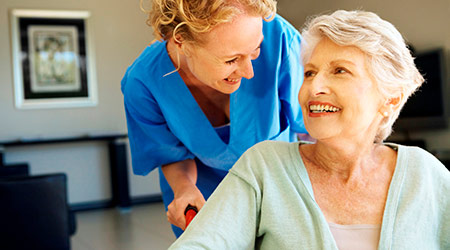While infection prevention should always be top of mind, the spotlight is never brighter than it is during flu season. A flu outbreak among senior residents can lead to serious health complications and potentially life-threatening conditions.
According to the Centers for Disease Control and Prevention (CDC), over four million Americans are admitted to or reside in nursing homes and skilled nursing facilities each year and nearly one million persons reside in assisted living facilities. In addition, they estimate that 1 to 3 million serious infections occur annually in long-term care facilities.[1]
There are several steps that facility managers can take to create a clean and hygienic environment for residents.
• Educate and train staff – It takes time and consistency to establish and maintain proper cleaning protocols, but once done, the eventual dividends of a formal cleaning training program can be significant. Employees who are trained properly may take more pride in improving residents' environments through correct cleaning and disinfecting techniques. Staff should be provided with regular formal trainings, procedures and tools like the free online training courses offered at P&G Professional University. Staff should also be educated on the difference between cleaning and disinfecting and how these processes impact the spread of infection. Cleaning is the process of removing soil from a surface as soil can harbor germs, such as influenza. Disinfecting is the process of killing the germs. Cleaning well allows disinfecting agents to work more effectively.
• Use multipurpose products to clean and disinfect – To simplify cleaning and disinfecting tasks while increasing efficiencies, use EPA-registered multipurpose product designed to clean a broad range of task areas and disinfect in one step. Product labels should indicate what bacteria and viruses a multipurpose product or stand alone disinfectant is effective against. Train staff to follow label instructions for proper usage and dwell times. Multipurpose products:
• Tackle broad range of soils/task areas
• Reduce rework/errors
• Balance performance with user safety
• Simplify cleaning and training
• Clean High-Touch Areas – Germs are pervasive in our environment and are easily spread through surfaces and contact with others. In fact, the aging population is at the highest risk from germs which kill more people than any other cause globally.
• Clean and disinfect resident’s rooms, restrooms, dining rooms and other common areas daily.
• Pay added attention to high-touch surfaces that are often missed, such as door handles, sink faucets, food trays, countertops, chairs, tables, light switches, toilet handles, handrails and elevator buttons.
• Consistently clean and disinfect these areas throughout the day to help get rid of germs. Sticky surfaces can indicate that the dirt could still be there.
• Additionally, staff should clean and sanitize mops and other cleaning tools to prevent cross contamination.
• Promote Hand Washing – Hand washing is one of the most important steps that staff and residents can take to help fight the spread of germs, bacteria and disease. Create and enforce proper hand washing protocol to reduce germs and keep staff accountable. Post hand washing reminders throughout the community for staff, residents and visiting families to follow. Also, ensure hand soap and hand sanitizer dispensers are well-stocked and accessible for everyone.
• Laundry – To achieve the proper level of hygiene in laundry procedures, it is imperative that cleaning professionals follow Centers for Disease Control and Prevention guidelines for laundry. Temperatures above 140º Fahrenheit are recommended for either the wash cycle and/or the dryer cycle. As a supplement to the temperature level, chlorine bleach may be used to meet hygienic criteria. However, when laundry is colored, bleach may not be appropriate, as the heat generated during the drying cycle can be used to achieve the necessary level of hygiene.
• Clean laundry can also reassure residents and their families that overall a facility is clean, as smell is one key indicator of cleanliness and this can affect not only a resident’s comfort level, but also the impression family members have of the facility. Cleaning and disinfecting with trusted brands and well-known products can provide a comforting, familiar experience that puts residents and guests at ease, particularly in the LTC sector, where familiar scents can help residents feel like they're in their own homes.
• Safe, Simple and Effective – A safe, simple and effective cleaning routine is part of creating a home-like environment for residents and helping avoid exposure to harmful germs that can lead to illness.
• Safe – Avoid corrosive or harmful chemicals that are hard on the skin or air and can pose respiratory challenges to someone with an already weakened system. Utilize closed loop packaging for concentrates to avoid chemical contact with employees.
• Simple – Use multipurpose cleaners that clean and disinfect in one step, cutting out extra steps and reducing chemical training costs
• Effective – Get the job done right the first time. Avoid rewashes, reduce exposure to both cleaning chemicals and soils.
Properly cleaning and disinfecting resident rooms and common areas can help reduce disease transmission, and facility managers should always be vigilant in their cleaning efforts and staff training. By promoting good hand washing practices, identifying high-touch surfaces and regularly cleaning and disinfecting, facility managers can help keep healthcare environments clean and hygienic. This, in turn, can help curb outbreaks and illnesses in facilities.
[1] https://www.cdc.gov/longtermcare/index.html
Michael Kupneski is the R&D Section Head for Procter & Gamble Professional.

 UF Health Hospitals Rely on Green Globes to Realize Their Full Potential
UF Health Hospitals Rely on Green Globes to Realize Their Full Potential How Healthcare Facilities Can Be Truly Disaster-Resilient
How Healthcare Facilities Can Be Truly Disaster-Resilient TriasMD Breaks Ground on DISC Surgery Center for San Fernando Valley
TriasMD Breaks Ground on DISC Surgery Center for San Fernando Valley Bigfork Valley Hospital Falls Victim to Data Breach
Bigfork Valley Hospital Falls Victim to Data Breach AI-Driven Facilities: Strategic Planning and Cost Management
AI-Driven Facilities: Strategic Planning and Cost Management